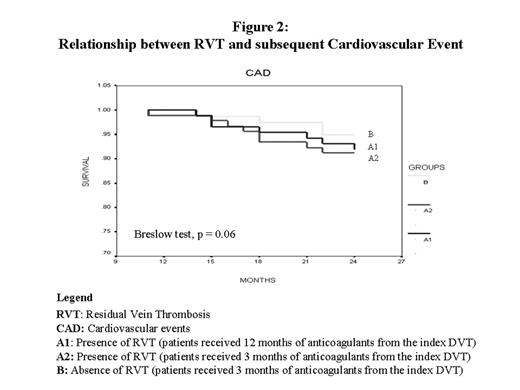Abstract
Background. We have recently demonstrated that the presence of Residual Vein Thrombosis (RVT), UltraSonography (US)-detected at the 3rd month after an episode of Deep Vein Thrombosis (DVT) of the lower limbs, is an independent risk factor for developing recurrent Venous Thromboembolism (VTE). The management of DVT patients by detection of RVT may, therefore, represent a simple and reproducible method for establishing the individual risk of recurrence and for tailoring the optimal duration of Oral Anticoagulants (OA) (
Objective of the study. In patients with DVT of the lower limbs, we conducted a prospective study for evaluating the correlation between RVT and the risk of new overt cancer and/or CD.
Materials and methods. Consecutive patients, with an episode of idiopathic or provoked DVT, were evaluated after 3 months from the index DVT; presence/absence of RVT was detected and patients managed consequently (table). The incidence of VTE recurrence, overt cancer and new CD was evaluated over a period of 3 years after the index DVT. Survival curves (Kaplan-Mayer) and related Breslow test have been used for statistics.
Results. Three-hundred fourty-five patients were included in the analysis. The results are listed in the table and figures. The incidence of recurrent VTE and new overt cancer was statistically lower in patients without RVT than in those with RVT; no significant differences were found in the incidence of new CD. These data are applicable in patients with idiopathic or provoked index DVT. In patients with RVT, the advantage of prolonging anticoagulation for 12 months was lost at the end of the treatment.
Conclusions. This is the first study evaluating the relationship between US-detected RVT and the risk of developing cancer and CD; RVT presence, at 3rd month from the index DVT, is an independent risk factor for recurrent VTE and indicates patients at risk for new overt cancer. This risk remains over a period of 3 years, independently whether index DVT was idiopathic or provoked. In these patients, the advantage of indefinite anticoagulation should be assessed in properly designed study.
Incidence of events over a period of 3 years accordingly to RVT findings
| Group . | Number of patients . | Presence of RVT at the 3rd months of OA from the index DVT . | Duration of OA from the index DVT . | Incidence of recurrent VTE . | Incidence of new cancer . | Incidence of new CD . |
|---|---|---|---|---|---|---|
| *Part of these patients were originally randomized to receive 3 or 12 months of OA | ||||||
| Group *A1 | 142 | yes | 12 months | 11 (7.7%) | 8 (5.6%) | 7 (4.9%) |
| Group *A2 | 91 | yes | 3 months | 16 (17.5%) | 9 (9.9%) | 7 (7.7%) |
| Group B | 112 | no | 3 months | 1 (0.9%) | 3 (2.6%) | 4 (3.5%) |
| Group . | Number of patients . | Presence of RVT at the 3rd months of OA from the index DVT . | Duration of OA from the index DVT . | Incidence of recurrent VTE . | Incidence of new cancer . | Incidence of new CD . |
|---|---|---|---|---|---|---|
| *Part of these patients were originally randomized to receive 3 or 12 months of OA | ||||||
| Group *A1 | 142 | yes | 12 months | 11 (7.7%) | 8 (5.6%) | 7 (4.9%) |
| Group *A2 | 91 | yes | 3 months | 16 (17.5%) | 9 (9.9%) | 7 (7.7%) |
| Group B | 112 | no | 3 months | 1 (0.9%) | 3 (2.6%) | 4 (3.5%) |
Relationship between RVT and subsequent Cancer
Relationship between RVT and subsequent Cardiovascular Event
Relationship between RVT and subsequent Cardiovascular Event
Author notes
Corresponding author



This feature is available to Subscribers Only
Sign In or Create an Account Close Modal